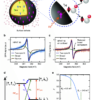As Rohit Velankar, now a senior at Fox Chapel Area High School, poured juice into a glass, he could feel that the rhythmic “glug, glug, glug” was flexing the walls of the carton.
Rohit pondered the sound, and wondered if a container’s elasticity influenced the way its fluid drained. He initially sought the answer to his question for his science fair project, but it spiraled into something more when he teamed up with his father, Sachin Velankar, a professor of chemical and petroleum engineering at the University of Pittsburgh Swanson School of Engineering.
They set up an experiment in the family’s basement and their findings were published in their first ever paper together as father and son.
“I became quite invested in the project myself as a scientist,” Sachin Velankar said. “We agreed that once we started on the experiments, we’d need to take it to completion.”
The paper is published in the journal Physics of Fluids.
The science behind the glug
Rohit’s first experiments found deli containers with rubber lids emptied faster than those with plastic lids.
“Glugging occurs because the exiting water tends to reduce the pressure within the bottle,” Velankar said. “When the container is highly flexible, like the bags that hold IV fluids or boxed wine, the container may be able to dispense fluid without glugging. But there are other types of flexible bottles out there, so surely their elasticity must affect its draining.”
They created their own ideal acrylic bottles with rubber lids using tools available at Fox Chapel Area High School’s makerspace. A sensor was placed near a hole at the bottom of each bottle to measure the pressure oscillations with each glug. The Velankars were able to simulate flexibility by adjusting the diameter of the hole, confirming that flexible bottles drain faster, but with bigger, more infrequent glugs.
More information:
Rohit S. Velankar et al, Soft bottles drain faster but glug slower, Physics of Fluids (2024). DOI: 10.1063/5.0217553
Provided by
University of Pittsburgh
Citation:
Science fair project leads to new research explaining the glugging effect (2024, September 10)



